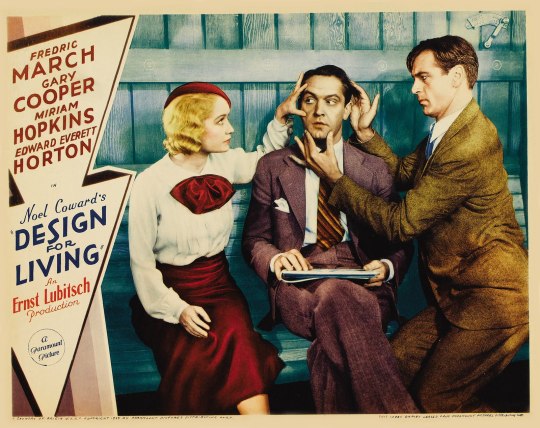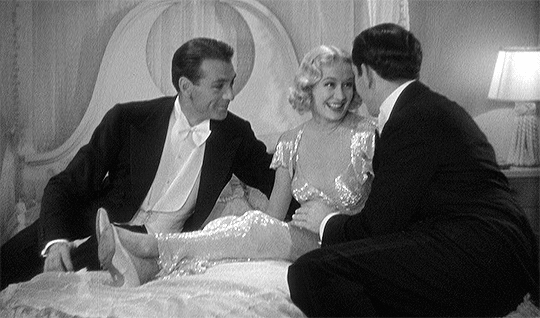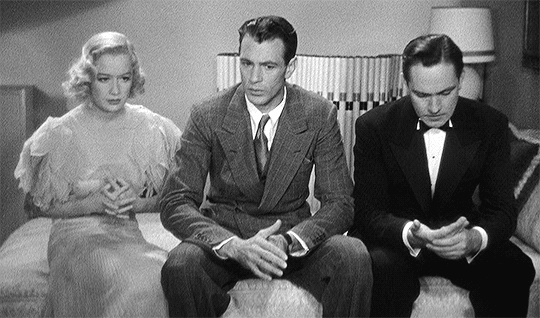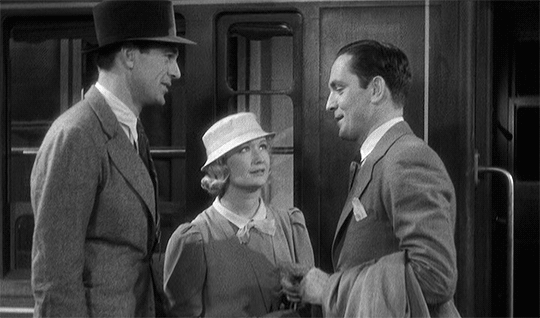#Design for Living (1933)
Explore tagged Tumblr posts
Text
three hearts that beat as one | old hollywood throuples anyone???
#old hollywood#classic hollywood#my post#my edit#yes yes they are not all throuples there are some that are 4. but you get the point!!!#btw three hearts that beat as one is a legit tagline for design for living#okay okay so lets get into identifying things. song: 3 - britney spears. films in order of appearance:#design for living#design for living 1933#the talk of the town#the talk of the town 1942#the philadelphia story#the philadelphia story 1940#singin in the rain#singin in the rain 1952#too many husbands#too many husbands 1940#fours a crowd#fours a crowd 1938#its love im after#its love im after 1937#my favorite wife#my favorite wife 1940#you can tell the relative throuple-ness roughly by how much they are featured lol. okay now for my OWN sake i must tag some actors#miriam hopkins#jean arthur#cary grant#katharine hepburn#james stewart#olivia de havilland
16K notes
·
View notes
Text

#polls#movies#design for living#design for living 1933#design for living movie#30s movies#old hollywood#ernst lubitsch#fredric march#miriam hopkins#gary cooper#edward everett horton#franklin pangborn#requested#have you seen this movie poll
128 notes
·
View notes
Text
Here to wake up the 3 other Design For Living fans.
#design for living#1930s polyamory#design for living 1933#polyamory#george curtis#gilda farrel#thomas b chambers#fredric march#miriam hopkins#gary cooper#edit#I am carrying this nonexistent fandom#someone help please
48 notes
·
View notes
Text

#design for living#miriam hopkins#fredric march#gary cooper#old hollywood#pre code hollywood#1930s#design for living 1933
23 notes
·
View notes
Text
Just watched “Design for Living” (1933), fun little movie I did enjoy it.
I’m a bit disappointed with how little we see the 3 of them actually living together. For those who don’t know, the movie is about Gilda (I really like her, she’s not like the stereotypical “oh I love you sm and I wanna do whatever you ask me” romance woman or the two-dimensional love interest) who’s in love with 2 men (heh, usually is the way ‘round) whose names are Tom (a playwriter) and George (a painter).
At first she suggests to live together in a platonic relationship and acts like a muse for the 2 men (launching both of their careers), but while Tom was away she and Gorge had sex (breaking the agreement) and they told him in a letter—> I found that scene a bit sad, because he was being so so excited about inviting them over at London (they used to live in Paris) to see the premiere of his play… Then he got the letter… And looked destroyed… And I was “Come on… That’s not cool.”
Then when Tom returned George was away and HE got sex with Gilda, George returned early and understood what happened and punched him and Gilda left both of them.
Btw those two have lived together for 11 years (“and they were roommates” ,’:) ), I think that during Gilda’s absence they returned staying together. At the end they both return to her (she had married with Plunkett during that time, but was very unhappy about it, she probably did it because of societal pressures and not to close that chapter of her life… Yk… An independent woman was not seen well at the time), they all get in the car (she gets a divorce btw, the movie shows how they work it out) and Tom then George kiss her in the mouth and they are all chill about it (she has always been, the two boys weren’t really happy with this) so… Poly?
I mean… She still mentions the gentleman’s agreement, but in this case they don’t mention sex (only hint at it)… So either they are ok with a platonic relationship or they just do poly, which for a 1933 movie it’s cool (ik it was pre-code, but still the 30’s)
So yeah… Nice lil movie :)
#rambles#ramblings#design for living#design for living 1933#old movies#I do admit that I’ve watched this movie just because I was interested in how it would’ve tackled those 3 living together#as I said a bit disappointed with that part of the film#but still… 1930’s#so it’s understandable#maybe this year I’ll write some thoughts for every film that I’ll watch… Who knows
4 notes
·
View notes
Text



"It's true we had a gentleman's agreement, but unfortunately, I am no gentleman."
Design for Living (1933)
directed by Ernst Lubitsch
767 notes
·
View notes
Text



this movie almost ended with the three of them in bed together....
#better throuple movie than challengers im not joking#i HATE monogomous het love triangles but this movie was NOT that#1933 huge year for bi poly men 👍#actually very glad i saw this AFTER challengers bcz this movie wouldve set my expectations for throuple movies WAY too high#i still love challengers ofc i just didnt think id love this movie sm more#charlie words#design for living
27 notes
·
View notes
Text

Ernst Lubitsch's "Design For Living" December 29, 1933.
#Ernst Lubitsch#Design For Living#1933#Thirties#Comedy#Romantic Comedy#Love Triangle#Pre Code#Gary Cooper#Fredric March#Miriam Hopkins#2/5
103 notes
·
View notes
Text


This Movie.
#fanart#design for living#1930s polyamory#design for living 1933#ernst lubitsch#gilda farrel#thomas b chambers#george curtis
26 notes
·
View notes
Text

this poster!!
#design for living#old hollywood#pre code hollywood#1930s#film#design for living 1933#miriam hopkins#gary cooper#fredric march
13 notes
·
View notes
Text
Hannah Arendt, who fled Germany in 1933, later wrote that long before Jews, Roma, gays, Communists and others could be herded into death camps, they had to be “denationalized” — excluded from the society that guaranteed their legal rights. Enlightenment thinkers had posited that just by virtue of existing, each person has inalienable rights. Arendt, however, observed that the “right to have rights” could be guaranteed only by a political community. Without a state to claim them as their own, people have no laws, no courts and no political mechanisms for protecting rights.
Arendt once said that “the generally political became a personal fate when one emigrated.” As a stateless person, she experienced that loss of rights — unable to get papers, hiding from the police, interned as an enemy alien in France — before making it to the United States. She was lucky. Her friend Walter Benjamin committed suicide in his eighth year of exile, when the French authorities blocked him from crossing the border ahead of advancing German troops...
A country that has pushed one group out of its political community will eventually push out others. The Trump administration’s barrage of attacks on trans people can seem haphazard, but as elements of a denationalization project, they fall into place...
The message, consistent and unrelenting, is that trans people are a threat to the nation. The subtext is that we are not of this nation...
The rights the Trump administration is taking away from trans people are relatively new. Only in the past few decades, for example, have clear legal procedures existed for changing the gender marker on identity documents, and only in the past few years have federal and some state authorities made the process fairly easy. But before transgender, gender-nonconforming and intersex people were recognized as a group — or groups — of people who had rights, many could blend in, fly below the radar. Now, in their new rightlessness, they are exposed...
Living with documents that are inconsistent or at odds with your public identity is no small thing. It can keep you from opening a bank account, applying for financial aid, securing a loan, obtaining a driver’s license and traveling freely and safely inside a country or across borders. I was once detained in Russia after a routine road check because an officer thought I was a teenage boy using his mother’s driver’s license.
It’s not just American identity documents that are being scrambled. Like all things American, Trump’s denationalization campaign affects people far beyond the United States. In late February, Secretary of State Marco Rubio issued visa guidelines, ostensibly designed to keep foreign trans athletes from competing in the United States, that seem to direct consular officers to deny entry to anyone whose gender markers appear different from their sex assigned at birth.
The new regulations require visitors, when filling out the paperwork to cross the border into the United States, to indicate the sex they were assigned at birth. Lucien Lambertz, a German curator who is trans and was planning a professional trip to the United States, told me they worried that they would be denied entry if they complied, indicating a birth sex different from the gender marker in their passport, but also if they didn’t comply.
Lambertz emailed the Foreign Ministry in their country to ask for guidance. “The issue is the subject of tense discussions here at the ministry, and your concerns are absolutely understandable,” the response read, in part. Ordinarily, the Foreign Ministry would suggest asking the U.S. Embassy, but by doing so, as the letter noted, Lambertz “would then ‘out’ yourself to them.”
Trans and nonbinary Germans fear that their country’s incoming conservative government may take its cues from the Trump administration. Far-right parties, ascendant in Germany and other European countries, have made the specter of “gender ideology” a centerpiece of their politics.
“Something has changed,” Heinrich Horwitz, a German choreographer, told me. Horwitz, who is nonbinary, was recently assaulted at the main train station in Vienna. The attacker was demanding to know whether Horwitz was “a girl or a boy.” Before they could make out what the attacker was saying, Horwitz instinctively tucked the Star of David they wear around their neck inside their shirt. “I thought that would be safer.” Horwitz, who was born in Munich in 1984, is the child of a Holocaust survivor. “I grew up with this idea that I could always go to the U.S. if the Nazis came back,” they told me. That no longer seems like an option.
You know how this column is supposed to end. I rehearse all the similarities between Jews in Germany in 1933 and trans people in the United States in 2025: the tiny fraction of the population, the barrage of bureaucratic measures that strip away rights, the vilifying rhetoric. The silence on the part of ostensible allies. (Trump spent about five minutes of his recent address to Congress specifically attacking trans people and 10 minutes attacking immigrants; the Democratic rebuttal mentioned immigrants once and trans people not at all.) Then I finish with the standard exhortation: The attacks won’t stop here. If you don’t stand up for trans people or immigrants, there won’t be anyone left when they come for you.
But I find that line of argument both distasteful and disingenuous. It is undoubtedly true that the Trump administration won’t stop at denationalizing trans people, but it is also true that a majority of Americans are safe from these kinds of attacks, just as a majority of Germans were. The reason you should care about this is not that it could happen to you but that it is already happening to others. It is happening to people who, we claim, have rights just because we are human. It is happening to me, personally.
2K notes
·
View notes
Text





Design for Living (1933) dir. Ernst Lubitsch
#design for living#miriam hopkins#gary cooper#fredric march#ernst lubitsch#classicfilmblr#classicfilmsource#film#filmedit#my edits#this movie lowkey blew my fucking mind lmao#happy lubitsch day to the twelve people who celebrate!!!!#i'm so upset he died so young!!!!#2k
2K notes
·
View notes
Text







Let’s change the subject. Right. Let’s talk about something entirely new. Let’s talk about ourselves. Very interesting. Fredric March and Gary Cooper in Design For Living (1933) dir. Ernst Lubitsch
#design for living#fredric march#gary cooper#oldhollywoodedit#classicfilmedit#ours#by jonah#1930s#film#classicfilmsource#userteri#usermichi#userdeforest#uservini#filmgifs
2K notes
·
View notes
Text


Fredric March and Gary Cooper on the Paramount lot during the filming of Design for Living (1933).
636 notes
·
View notes
Text

I don't know what to think of this. I adore old mills that are converted to homes, but only if they keep the original workings. This, however, is something I've never seen before. As you can see, everything is still here, but they completely gutted the interior of the 1933 mill in Clemmons, NC and modernized it. They left the exterior intact (and, it's still fully operational). 3bds, 4ba, 6,713sqft, $1.75m.

Approaching the front entrance to the home.

Super modern entrance hall.

Look at this. Well, at least the stone walls are still there.


There's this weird long counter where you can be served from the kitchen. Maybe they were planning on a tourist trade?


The modern kitchen.


Living/dining room off of the main entrance hall.


Hi-tech primary bedroom has sleek built-ins.

Check out the illuminated tub.

The bathroom is like a greenhouse. No privacy at all.

There's also a walk-in closet.

Bedroom #2 has a fireplace flanked by built-in dressers.


The modern ensuite.

And, the built-ins of bedroom #3. They're all unique designs.

Ensuite #3.

There's a glass window in the wall of the home theater where you can observe the new electronic workings of the mill.



Here's a guest house.

Patio with a full outdoor kitchen.

The river that powers the mill.

This dome must be a window into the workings of the mill.

It has beautiful park-like grounds.

It's a beautiful property, I just wish they hadn't modernized it so much.

2.94 acres of land.
https://www.zillow.com/homedetails/7951-Lasater-Rd-Clemmons-NC-27012/5802414_zpid/
239 notes
·
View notes
